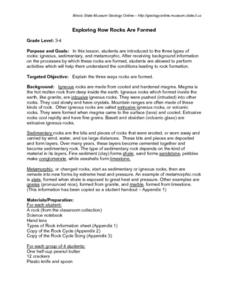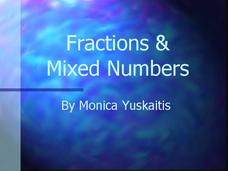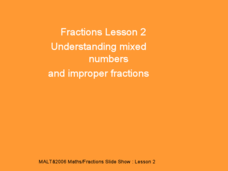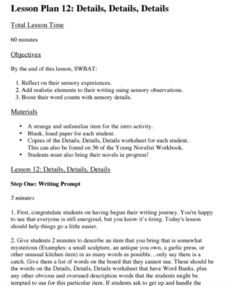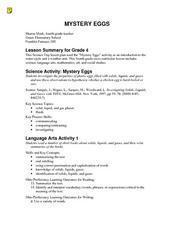Curated OER
Exploring How Rocks Are Formed
These lessons produced by the Illinois State Museum are quite good. In this one, third and fourth graders are introduced to the three basic types of rocks: igneous, sedimentary, and metamorphic. They perform activities which help them...
Jupiter Images Corp.
To, Too, and Two
The most pesky of homophones: to, too and two! Here's a worksheet to help you review and discuss what homophones are and how to correctly use them in sentences. Learners choose the correct word for 20 sentences. This can serve as an...
Curated OER
The Legacy of Margaret Thatcher: The Iron Lady
In the wake of her recent passing, spend some time acquainting your class with the life of a woman who was highly influential in politics.
DK Publishing
Tricky Word Problems, Part 2 - Choosing the Operation
Can your learners figure out which equation to solve? Use this resource to challenge your third graders with word problems involving the four operations. Each problem has a section to write the answer, but pupils will need to write out...
Curated OER
iPad Apps for Your Special Education Class
Swing into technology with these special education apps that are perfect for your learners.
Curated OER
Fractions and Mixed Numbers
This series of math presentations by Monica Yuskaitis is outstanding! This installment teaches youngsters about fractions and mixed numbers. The graphics, examples, and text throughout this presentation are engaging and should help...
Curated OER
Fractions Lesson 2 - Mixed Numbers and Improper Fractions
Here is an excellent presentation on the difference between mixed numbers and improper fractions. Young mathematicians are given a clear definition of each, and the ensuing slides give lots of great practice in calculating these values....
Curated OER
Classifying Triangles
If you're looking for a presentation to assist you in your teaching of triangles, this one could be for you. In it, learners are shown how triangles are classified by the size of their angles and by their sides. These are tricky concepts...
Curated OER
Oral traditions: Facilitating education through verbal traditions
Bring oral traditions into the classroom to engage learning and facilitate best practices. From story telling to listening skills, this article provides reasons and rational behind oral traditions as a tool for education.
Curated OER
How to Implement Project Based Learning to Engage Students
Can a math teacher employ project-based learning? Learn how one great math teacher uses PBL to design math projects that provide learners with a more challenging and holistic learning experience. A wonderful article, that includes three...
Curated OER
The Mighty Apostrophe
Here is a well-designed presentation on apostrophes and their many uses. The apostrophe is used in many different ways, and this PowerPoint does a great job of showing how it's used. There is a nice interactive component built in, and...
Curated OER
What a Square
Students examine the painting "Old Man With A Gold Chain" by Rembrandt. They identify geometric shapes in the painting, measure these shapes and compare the relationships of these measurements.
DK Publishing
Number Sentences: Dividing by 4
Division can be a picnic! Given illustrations of picnic foods, such as sandwiches, drinks, and cupcakes, third graders practice their money math and division skills. Have them color the page when they're finished, or bring division to...
Curated OER
Go Fish!
Students share a bowl of goldfish crackers. In this lesson plan on sharing, students see how a limited resource goes furthest when it is evenly shared. Students are allowed to take as many crackers as they would like, and then in...
DK Publishing
Real-life Word Problems, Part 4
Bring math to real life with this review resource! With five word problems on bars of chocolate, boxes of tissues, and bottles of lemonade, this is an excellent way for fourth graders to apply their math knowledge to real life scenarios....
Curated OER
Cityscapes
A perfect resource for an art teacher of any grade. First, click on the resource's second tab, entitled "Activities," to find four unique grade-specific lesson all based on the theme of cityscapes. Each activity utilizes the included...
Curated OER
Lesson: Snake Handling
Are the studies of art and archeology connected? You bet they are! Young scholars research the ancient temples of Mexico by visiting an archaeology site. They describe the various temples they see, taking note of shapes, stairs, details,...
DK Publishing
Sorting Animals
How many legs does a lion have? What about a bird? How many legs does a snake have? A counting assignment prompts kindergartners to sort the animals by the amount of legs they have. After kids finish matching, they can color the animals...
Curated OER
Art Smart!
Here is an amazingly thorough, and detailed, lesson plan on elements of art and art appreciation. Designed for third graders, this series of lessons should open up the eyes of your charges to the wonderful world of art that is all around...
DK Publishing
Real-Life Word Problems, Part 6
Bring math alive with these five word problems. Using multiplication and division in a space for writing equations, fourth graders solve the word problems and practice writing out the answers in a separate area. Helpful as either a...
Curated OER
Details, Details, Details
Writing can become one-dimensional if authors don't involve all their senses. First, scholars observe a strange object which, ideally, they can touch and even smell. Without using certain words (you can create a list or have the class...
Curated OER
The Bear Facts
Students explore various kinds of bears and gather information about them. In this research and habitats lesson, students chart their bear information on large posters with illustrations of their bears. Students map the locations where...
Curated OER
Mystery Eggs
Students investigate the properties of plastic eggs filled with solids, liquids, and gases and use these observations to hypothesize whether a chicken egg is hard-boiled or raw.
Curated OER
Eggs'ceptional Experiments
Students see evidence of chemical reaction and follow the scientific method to hypothesize, observe, and reach conclusions. They conduct a series of egg based experiments such as forming crystals and complete journal activities as a...


